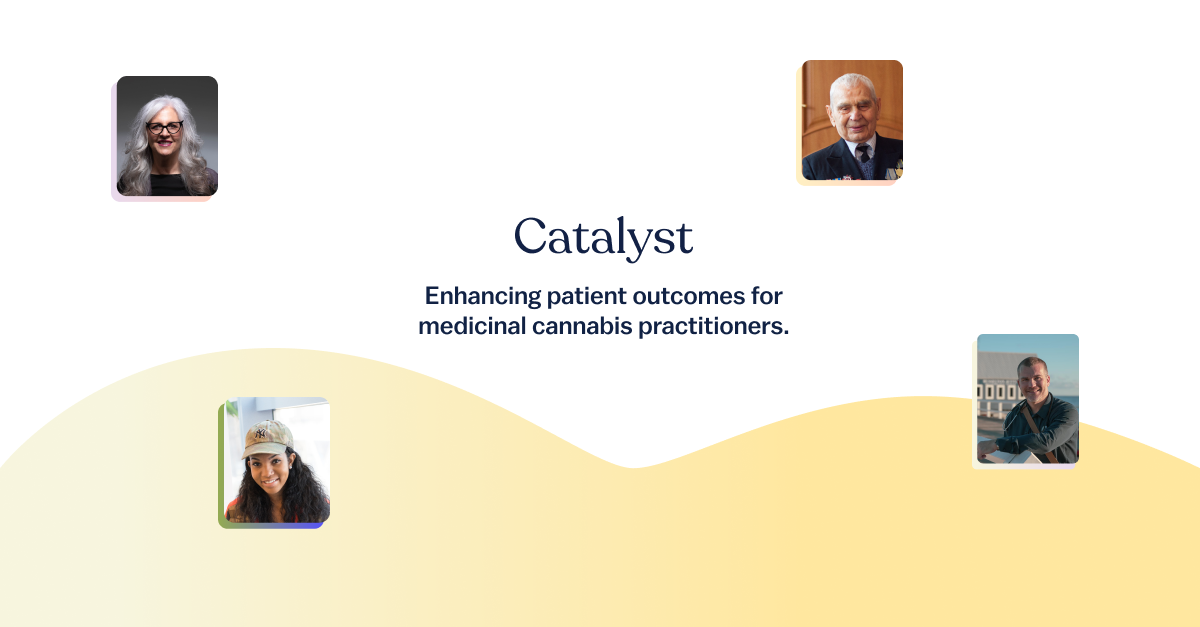Common Terpenes: Their Benefits, Doses & Effects
This article is part two of our terpene series. Please read part one, Understanding terpenes and medicinal cannabis, if you’d like some background.
Terpenes and their benefits
Once you understand the basics of terpenes, you must start to learn about how to administer terpenes when treating a patient with medicinal cannabis. In this article, you’ll learn about terpenes in specific delivery methods, how much of a terpene is enough to have an impact, and you’ll get an overview of the top 5 terpenes and their benefits.
Please remember that terpenes may have some side effects. While we don’t explicitly list the side effects for each of the terpenes discussed in this article, you can learn about the potential side effects of terpenes in part one of the series.
In this article, we cover:
- How much of a terpene is needed to have medical benefits?
- Smoking vs vaping cannabis and terpenes
- Structural types of terpenes and destruction of terpenes
- Most common terpenes and their benefits
You can also visit the accompanying article which has an infographic of terpenes and terpene vaporisation temperatures.
How much of a terpene is needed to have medical benefits?
If you’ve ever experienced just a drop of lavender under your pillow, you’ve experienced a tiny dose of terpenes, and often even that amount can have an impact.
Nurse Cam
Like the cannabinoids themselves, there isn’t a specific dose of terpene that will have a medicinal effect. However, terpenes are highly bioactive and generally do not require large quantities to produce a physiological response. Each person is different and will need different amounts of a terpene to potentially achieve the benefits they require.
When adding cannabis or terpenes into your medical regime, it’s important that the prescriber and patient set treatment goals. While the health professional will guide the treatment, it’s essential to work together to determine what outcomes in symptom reduction or improvement in quality of life would be seen as a success and then work toward those goals with the medicine.
It’s recommended that you take a start low and go slow approach. If not working, remember that more does not necessarily mean better.
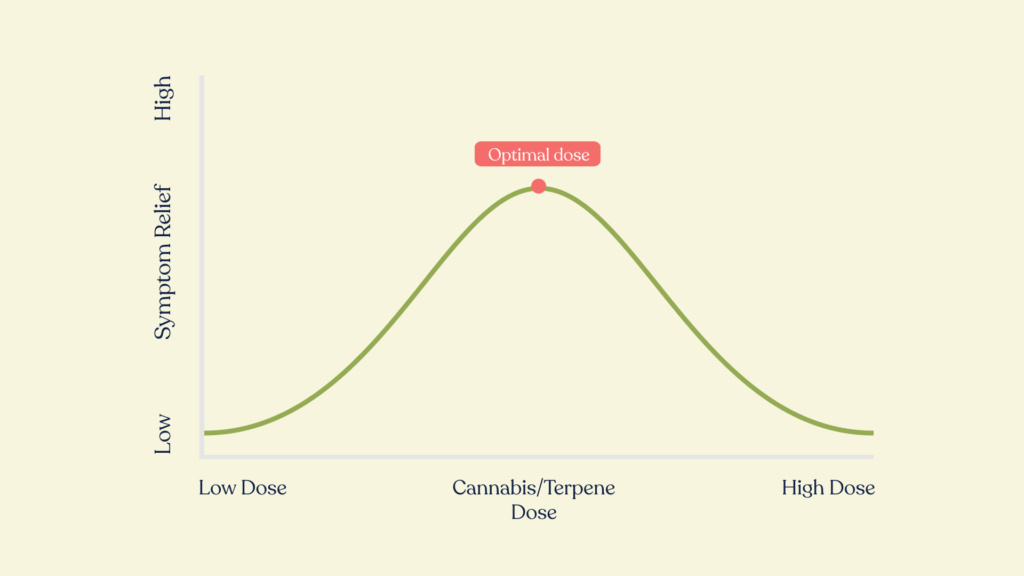
Cannabinoids and many terpenes have bi-directional effects, and there are some guides for the tolerability of terpenes.
Limonene, for example, has been shown to be tolerated in doses of up to 2g per day. On the other hand, Linalool has demonstrated significant anxiolytic properties in dosages between 30mg – 120mg. And camphene and humulene are irritants when dosed in over 1000mg.
It will be up to the patient with the health professional’s guidance to determine if the terpenes provide benefits.
Smoking vs vaping cannabis and terpenes
While full spectrum, broad-spectrum and terpsolate cannabis products of various types contain terpenes, flower products offer the benefits of the whole plant. And, many patients who are prescribed flower end up smoking it rather than using a vaporiser. Therefore, health professionals must understand the benefits of vaping over smoking and guide their patients on using a vaporiser to get the most out of their medication.
It’s important to know that many Australians who have self-medicated are used to smoking cannabis with tobacco (spin). This can cause various health issues and more significant potential for addiction. While there are some obvious benefits of choosing a dry herb vaporiser and removing the tobacco, there are some less obvious benefits related to the effect of the medication.
Utilising terpenes by understanding boiling/smoke point
Terpenes and cannabinoids are fragile compounds. As a result, they have very low boiling/smoke points. The boiling/smoke point is the temperature at which the chemical activates and begins to offer a medicinal benefit. If you take the plant much further than that boiling/smoke point, the cannabinoid or terpene is destroyed.
When smoking cannabis flower, the plant matter can go beyond 2000℃, and most cannabinoids and terpenes are destroyed, thus losing many therapeutic effects.
So, if you know the cannabinoid and terpene boiling points and consume your medicine with the boiling points and terpene profile in mind, you can better elicit the effects you want from that plant matter.
How do you know which terpenes are in your medicinal cannabis?
Medicinal cannabis product suppliers should all have Certificates of Analysis (CoAs or CofAs) for each product batch. Patients and health professionals may request the CoA from the product supplier or view them via Catalyst to learn more about what’s in the medicine they are prescribing/consuming.
While a limited number of companies are testing terpenes in their non-flower products, some do. Most suppliers offer CoAs that include terpenes for their flower products, whereas some only provide a terpene template that says what terpenes and values ‘should’ be in each batch.
It’s also important to know that cannabis products will not be exactly the same from batch to batch. That said, they should be similar. Unfortunately, without understanding what cannabinoids and terpenes are in a full or broad-spectrum product, it’s impossible to know whether they are the same (or similar enough) from batch to batch.
Terpene structural types
The structural type of the terpene determines how fragile the terpene is and what the range of the boiling point of that terpene is.
Terpenes are made of hydrocarbons. The number of carbons rings determine whether a terpene is a:
- Monoterpene – 10 carbons
- Sesquiterpene – 15 carbons
- Diterpenes – 20 carbons
- Triterpenes – 30 carbons
The larger, the more stable, which means degradation of terpenes will happen more slowly. Monoterpenes are considered the most fragile terpenes and include limonene and pinene. On the other end of the spectrum, triterpenes are the strongest of the terpenes and will have a higher boiling/smoke point.
What are some of the things that destroy terpenes?
Terpenes are very fragile and can be destroyed very easily. Some of the things that hurt a plant’s terpene profile are:
- Rough shaking of cannabis flower
- The curing process
- Sterilisation (irradiation)
- Temperature and incorrect storage of cannabis products
- A change in moisture
- Time – the longer a product is unused
Research has shown that irradiation can reduce terpenes by approximately 10 to 40 per cent.
Common Terpenes & Their Effects
This section will cover some of the most common terpenes, potential benefits, and where the terpenes can be found outside of cannabis. You must understand terpene basics to make the best product decisions for your patients. Remember that while terpenes are relatively safe and we are listing potential benefits, there are also possible side effects at high doses.
Pinene
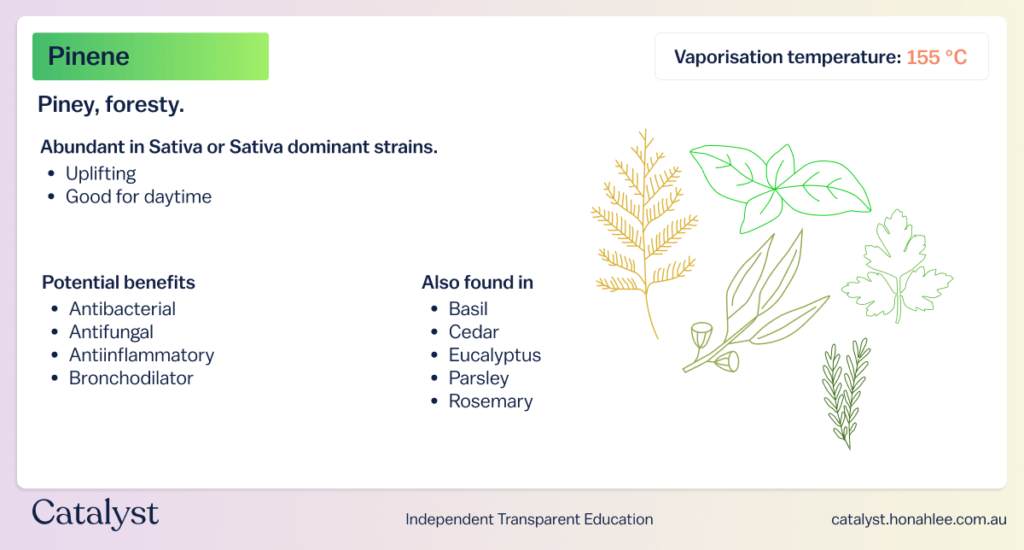
Pinene is one of the most abundant terpenes in nature and is a monoterpene. Pinene can be found in:
- Basil
- Cedar
- Conifer trees
- Eucalyptus
- Parsley
- Rosemary
- And many other plants
Pinene smells like pine and has a broad range of potential benefits that have been documented in preclinical studies. Some of the potential benefits of pinene are:
- Anti-inflammatory activity via prostaglandin E1
- Acetylcholinesterase inhibition, increasing acetylcholine levels in the brain and potentially mitigating short-term memory deficits induced by THC.
- Bronchodilation at low exposure levels.
- Anxiolytic effects at benzodiazepine-GABA receptors.
Myrcene
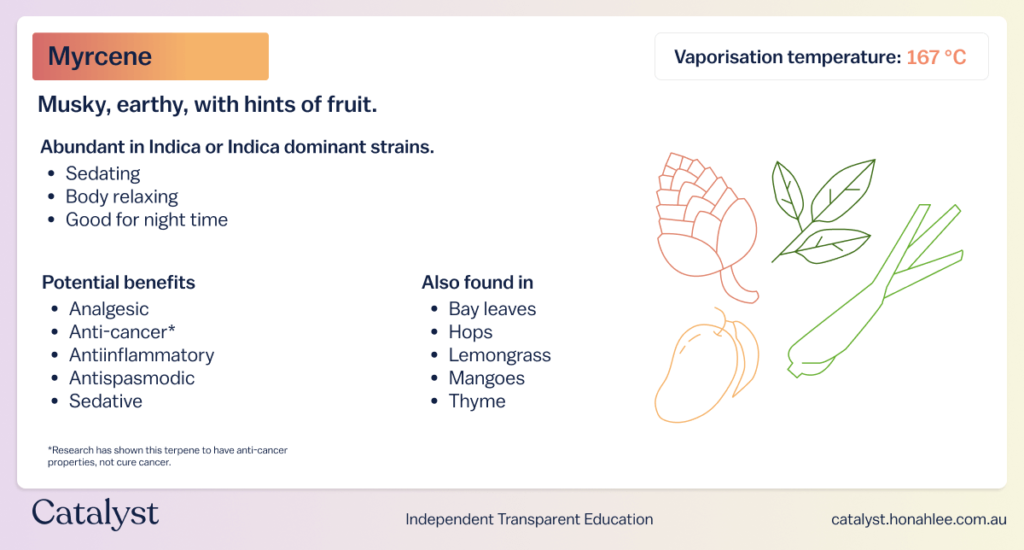
Myrcene is a terpene often thought to be one of the major defining factors of the ‘Indica’ cannabis species. It’s a monoterpene found commonly in:
- Hops
- Lemongrass
- Thyme
- And many other plants.
Myrcene’s aroma is often described as earthy and musky, resembling cloves. Preclinical research indicates several potential benefits, including:
- Anti-inflammatory activity via prostaglandin E2
- Anticarcinogenic activity against aflatoxin in the liver
- Long-lasting analgesia involving a2 adrenoceptors and u-opioid receptors
- Muscle relaxation and sedative effects
- Prevention of peptic ulcers with increased mucus production decreased levels of superoxide dismutase and increased levels of glutathione
- Prevention of Ischaemia-Reperfusion Oxidative injury
Limonene
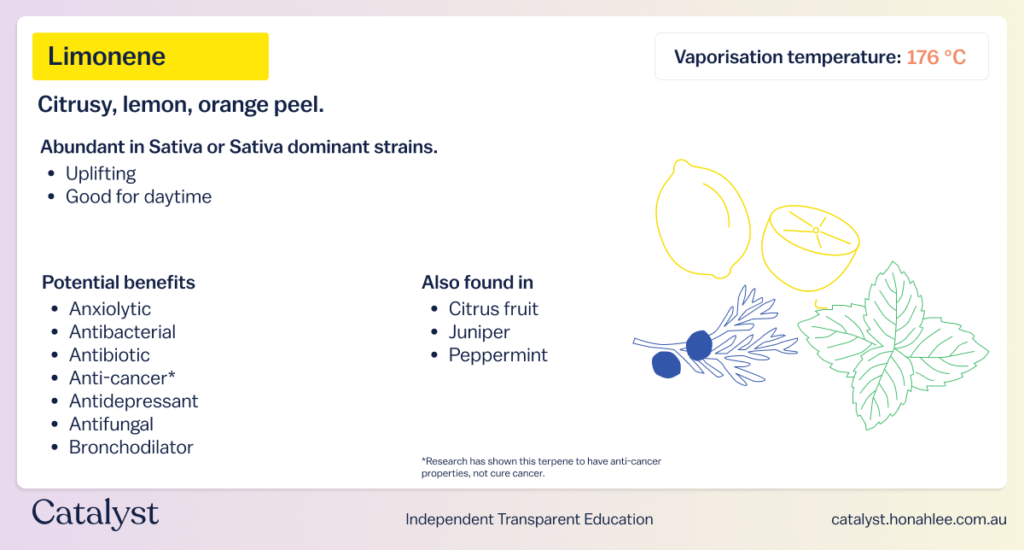
D-Limonene is a monoterpene found in large concentrations in citrus plants. Limonene’s aroma is described as sweet and lemony but without sharpness. Limonene demonstrates high bioavailability, rapid metabolism and low toxicity, and preclinical studies have found the following potential pharmacological effects:
- Anxiolysis mediated via 5-HT1A receptors, boosting serotonin levels in prefrontal cortex and dopamine in the hippocampus (Ref)
- Increased mouse motility by 32.25% after inhalation and decreased activity after caffeine by 33.19%. (Ref)
- Prominent antibiotic effects (Ref)
- Induction of apoptosis in breast and colon cancer cells (Ref)
- Agonist activity at A2A adenosine receptors (Ref)
- Reduced hyperalgesia (Ref)
- Increased mitochondrial biogenesis (Ref)
- Significant antiulcer properties (Ref)
- Gastroprotectant properties (Ref)
Linalool
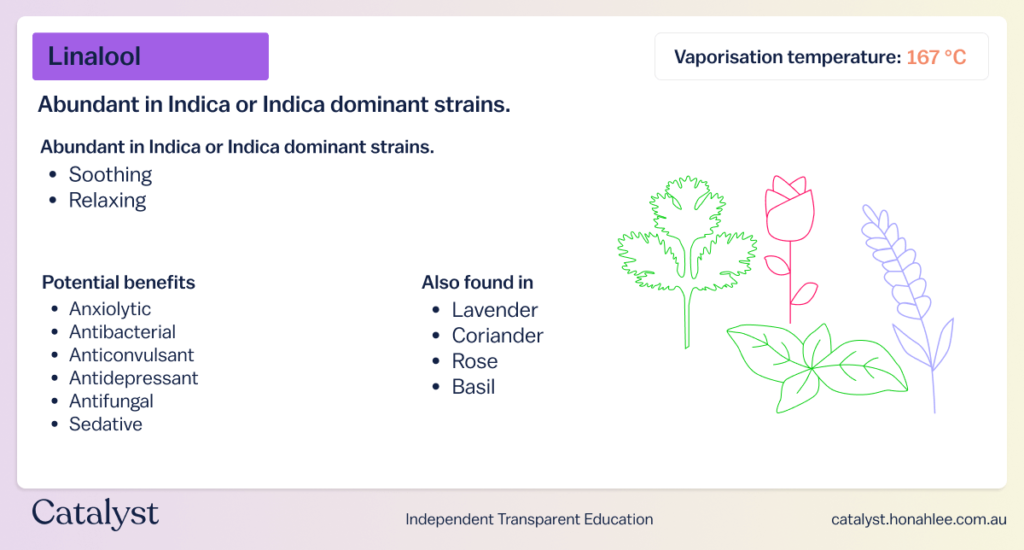
Linalool is one of the primary therapeutic agents within lavender and is a monoterpenoid. It’s present in
- Lavender
- Coriander
- Rose
- Basil
- And other botanicals
Some of the potential pharmacological properties of Linalool include:
- Anxiolytic and sedative effects at GABA receptors (Ref)
- Anticonvulsant and antiglutamatergic, promotion of axonal regeneration (Ref)
- Anti-inflammation through inhibition of COX-2 and activation of Nrf2/HO-1 signalling pathway (Ref)
- Antihyperlipidemic (Ref)
- Antibacterial and antifungal (Ref)
- Local anaesthesia comparable to procaine and menthol (Ref)
Caryophyllene

B-caryophyllene (BCP) is a sesquiterpene and is most notably a selective strong full agonist at the CB2 receptor and an agonist of the PPAR-y receptor, lending it the unique title of a ‘dietary cannabinoid’ (Ref 1, Ref 2, Ref 3). BCP is commonly found in:
- Clove
- Black pepper
- Hops
- Thyme
- And other plants and botanicals
BCP is often found in high levels within cannabis. Its aroma can be described as sharp and peppery with light sweet notes. It has demonstrated therapeutic benefits in numerous animal models against the following conditions:
- Inflammatory arthritis
- Nervous system diseases
- Atherosclerosis
- Streptococcus infections
- Osteoporosis
- Seizures
- Hepatic injury associated with oxidative stress, inflammation and steatosis (Ref).
- Nausea
To learn about Terpinolene, Humulene and Ocimene, you can start watching the accompanying video at 13:50.
Conclusion
As you can tell by now, terpenes may be beneficial in any treatment regime. Quite often, even using essential oils in a diffuser can impact a patient’s sense of wellbeing. When it comes to cannabis, it’s important to know whether your preferred products contain terpenes so you can begin to determine if the terpenes are having an impact on your patient.
If you’d like to learn more about terpenes, you can review and download our terpene quick guide, which lists terpenes, their benefits, and smoke/boiling points.
If you’d like to learn more about which products contain terpenes and compare terpene values between all different types of products, you can start a free trial to review Catalyst’s CoAs and use the comparison tools.
